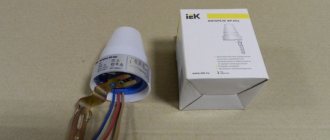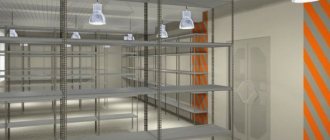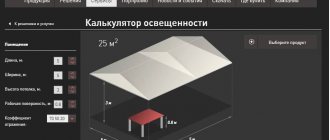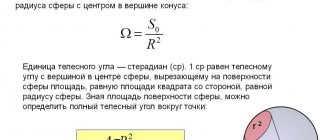Any light source is a source of luminous flux, and the greater the luminous flux that hits the surface of the illuminated object, the better this object is visible. And the physical quantity, numerically equal to the luminous flux incident on a unit area of the illuminated surface, is called illumination.
Illumination is denoted by the symbol E, and its value is found using the formula E = F/S, where F is the luminous flux and S is the area of the illuminated surface. In the SI system, illumination is measured in Lux (Lx), and one Lux is the illumination at which the luminous flux incident on one square meter of the illuminated body is equal to one Lumen. That is, 1 Lux = 1 Lumen / 1 Sq.m.
As an example, here are some typical illumination values:
- Sunny day in mid-latitudes - 100,000 lux;
- Cloudy day in mid-latitudes - 1000 Lux;
- A bright room illuminated by the rays of the sun - 100 Lux;
- Artificial lighting on the street - up to 4 lux;
- Light at night with a full moon - 0.2 Lux;
- The light of the starry sky on a dark moonless night is 0.0003 Lux.
Imagine sitting in a dark room with a flashlight and trying to read a book. To read, you need an illumination of at least 30 Lux. What will you do?
- First, you bring the flashlight closer to the book, which means the illumination is related to the distance from the light source to the illuminated object.
- Secondly, you place the flashlight at a right angle to the text, which means the illumination also depends on the angle at which this surface is illuminated.
- Thirdly, you can simply get a more powerful flashlight, since obviously the illumination is greater if the light source is stronger.
Let's say a light flux hits some screen located at some distance from the light source. Let us double this distance, then the illuminated part of the surface will increase in area by 4 times. Since E = F/S, the illumination will decrease by as much as 4 times. That is, illumination is inversely proportional to the square of the distance from a point source of light to the illuminated object.
Illumination is calculated using the formula
When a beam of light falls at a right angle to the surface, the luminous flux is distributed over the smallest area; if the angle is increased, the area will increase, and the illumination will decrease accordingly. As noted above, illumination is directly related to the intensity of light, and the greater the intensity of light, the greater the illumination. It has long been established experimentally that illumination is directly proportional to the intensity of the light source.
Of course, the illumination decreases if the light is obstructed by fog, smoke or dust particles, but if the illuminated surface is located at right angles to the light source, and the light propagates through clean, transparent air, then the illumination is determined directly by the formula E = I / R2, where I is the luminous intensity, and R is the distance from the light source to the illuminated object.
During the daily operation of lighting installations, a decrease in illumination is possible, therefore, to compensate for this shortcoming, a special safety factor is introduced at the design stage of lighting installations. It takes into account the decrease in illumination and brightness during the operation of lighting devices due to contamination, loss of reflective and transmitting properties of reflective, optical, and other elements of artificial lighting devices. Surface contamination, lamp failure, all these factors are taken into account. For natural lighting, a reduction coefficient of KEO (natural illumination coefficient) is introduced, because over time, the translucent fillers of light openings may become dirty, and the reflective surfaces of the premises may become dirty.
The European standard determines illumination standards for different conditions, for example, if in the office there is no need to examine small details, then 300 Lux is enough, if people work at a computer - 500 Lux is recommended, if drawings are made and read - 750 Lux.
Illuminance measurement
Illumination is measured with a portable device - a lux meter. Its operating principle is similar to a photometer. Light hits the photocell, stimulating a current in the semiconductor, and the amount of current produced is just proportional to the illumination. There are analog and digital light meters. Often the measuring part is connected to the device with a flexible spiral wire so that measurements can be taken in the most inaccessible, yet important places. A set of light filters is attached to the device to adjust the measurement limits taking into account the coefficients. According to GOST, the instrument error should be no more than 10%.
We measure illumination with a lux meter
When measuring, follow the rule that the device must be positioned horizontally. It is installed one by one at each required point, according to the GOST scheme. GOST, among other things, takes into account security lighting, emergency lighting, evacuation lighting and semi-cylindrical lighting, and also describes the measurement method. Measurements for artificial and natural light are carried out separately, and it is important that no random shadow falls on the device. Based on the results obtained, using special formulas, a general assessment is made, and a decision is made whether something needs to be adjusted, or whether the illumination of the room and area is sufficient.
Calculation of luminous flux
How can you find out the approximate light flux in lumens, without any measuring instruments at all? Here you can use the light output values and their proportional dependence to the flow.
- for LED lamps with a frosted bulb - multiply the lamp power by approximately 80lm/W and find out how many lumens it contains
- for filament - multiply the lamp power by 100
- energy saving CFL – 60lm/W
- DRL = power * 58lm/W
Workplace illumination
Lighting is extremely important for humans. With the help of vision, a person receives most of the information (about 90%) coming from the surrounding world. Light is a key element in our ability to see, evaluate the shape, color and perspective of objects around us. Lighting affects not only the functioning of the visual apparatus, that is, it determines visual performance, but also the human psyche and emotional state. Researchers have accumulated a significant amount of data on the biological effects of visible light on the body. A comparative assessment of natural and artificial lighting based on its effect on performance shows the advantage of natural light. The leading factor determining the biological inadequacy of natural and artificial light is the difference in the spectral composition of radiation, as well as the dynamism of natural light during the day.
Workplace illumination
When working under poor quality or low levels of lighting, people may experience eye fatigue and fatigue, leading to decreased performance. In some cases, this can lead to headaches. The reasons in many cases are too low light levels, glare from light sources and brightness ratios that are not well balanced in the workplace. Headaches can also be caused by lighting pulsation, which is mainly a result of the use of electromagnetic ballasts for discharge lamps operating at a frequency of 50 Hz. From an occupational safety point of view, visual ability and visual comfort are extremely important.
In order to provide the conditions necessary for visual comfort, the lighting system must meet the following prerequisites:
- sufficient and uniform lighting
- optimal brightness
- no glare or glare
- appropriate contrast
- correct color scheme
- no stroboscopic effect or light pulsation
Each type of activity requires a certain level of illumination in the area where this activity is carried out. Typically, the more visually impaired, the higher the average light level should be. It is important to consider light in the workplace, guided not only by quantitative, but also by qualitative criteria.
The following quality characteristics of lighting and ways to improve them can be identified:
Direct shine
High-brightness surfaces within a person's field of vision can produce an unpleasant, uncomfortable sensation or cause a state of blindness. As a result, visual performance decreases sharply. Sources of direct glare are lighting installations and light sources.
Direct gloss reduction can be achieved:
- increasing the installation height of lamps
- reducing the brightness of lamps by covering light sources with light-diffusing glass
- limiting the light intensity in directions forming large angles with the vertical, for example, using lamps with the required protective angle
- reducing the power of each individual lamp due to a corresponding increase in their number
Reflected gloss
Occurs when the reflection coefficients of surfaces falling into the field of view are high. The greatest danger arises when illuminating surfaces that are not diffuse, when the light falls on the working surfaces in such a way that the eyes are in the direction of specular reflection of the rays. In this case, a person sees either a mirror reflection of the light source or a blurry but very bright spot of light. In both cases, a state of blindness may occur, but more often the effective contrast between the detail and the background is reduced. Elimination of reflected glare is achieved by the correct organization of localized lighting and the arrangement of lamps so that the rays specularly reflected by the surface do not enter the eyes. To do this, it is best to do the lateral or posterolateral direction of the light.
Contrast between subject and background
The brighter the object, the greater the light flux from it enters the eye and the stronger the signal coming from the eye to the visual center. Thus, it would seem that the greater the brightness, the better a person sees the object. However, this is not quite true. If the surface (background) on which the object is located has a brightness close to the object (for example, a pale yellow line on a white sheet), then the intensity of illumination of the retinal areas by the light flux coming from the background and the object is the same (or slightly different ), the magnitude of the signals entering the brain is the same, and the object against the background becomes indistinguishable.
For an object to be clearly visible, the brightness of the object and the background must be different. The difference between the brightness of the object and the background, divided by the brightness of the background, is called contrast. The contrast between details and background, which most determines the visibility of an object, is not always given and can be increased or decreased by means of lighting and the creation of a light environment. One effective means of increasing contrast is an artificial background (usually light if the subject is dark, or dark if the subject is light). A variety of artificial backgrounds are light tables, on which surfaces are viewed in transmitted light.
Shadows
A distinction is made between intrinsic shadows formed by the surface topography and shadows falling from objects located outside the working surface - equipment, furniture, human body and hands, etc. In most cases, intrinsic shadows are useful because they allow you to better distinguish the configuration of a part. Falling shadows are almost always harmful. Their harm lies in the fact that they distort contrast, distract attention, etc. Moving shadows are especially harmful. Eliminating or limiting harmful shadows is achieved by choosing the correct direction of light. For example, when a person writes with his right hand, he looks at the working point on the left and the light should fall from the same side. Shadows blur as the size of lighting installations increases, soften when the brightness of walls and ceilings is high enough, and almost disappear with indirect lighting.
Saturation of the room with light
To create comfortable visual conditions for a person, it is important not only the illumination of any surface on which work is carried out, but also the impression that a person receives of the saturation of the room with light. Even if the working surface is sufficiently bright, the simultaneous presence of dark surfaces in the field of vision (for example, walls, ceilings, furniture, equipment) creates difficulties in adapting vision. The brightness of these surfaces determines the impression of light saturation in the room. If the room has direct light pendant lights, the upper area of the room will remain dark. This produces an unpleasant aesthetic and psychological impression. Therefore, it is better to use light colors for walls and ceilings, and for lighting use lamps that emit some (preferably at least 15%) part of the light flux into the upper hemisphere.
Consistency of illumination over time
Changes in illumination over time can be divided into slow and smooth, frequent fluctuations and pulsations. Slow changes are caused by gradual changes in the mains voltage and factors that change the illumination during operation (pollution of light sources, decreased light output, etc.). If the illumination remains at a level not lower than the standard value, these changes are not harmful. The reason for frequent fluctuations is the movement of lamps, their swinging by air movement (wind, draft, ventilation unit, etc.) and voltage fluctuations in the network generated by changes in load.
Ripple
Illumination pulsations are due to the low inertia of the radiation of gas-discharge lamps; the light flux pulsates with alternating current of industrial frequency (50 Hz) with a double frequency - 100 Hz. These pulsations are indistinguishable when observing a stationary surface with the eye, but are easily detected when examining moving objects. If, under pulsating lighting, you quickly wave a pencil against a contrasting background, the pencil acquires clearly visible contours. This phenomenon is called the stroboscopic effect - the phenomenon of distortion of the perception of moving or rotating objects of observation. A practical danger of the stroboscopic effect is that rotating parts of machinery may appear to be stationary, rotating at a slower speed than they actually are, or in the opposite direction. This may cause injury. However, pulsating illumination is also harmful when working with stationary surfaces, causing visual fatigue and headaches.
Peripheral vision is most sensitive to pulsations and therefore they are dangerous in general lighting. An unfavorable effect of light fluctuations on the photoreceptor elements of the retina, as well as on the functional state of the nervous system, was also revealed, which is associated with the development of inhibitory processes and a decrease in the lability of nervous processes. The impact of pulsation increases with increasing depth and decreases with increasing frequency. Most researchers note the negative impact of pulsating illumination on human performance, both during long-term exposure to pulsating lighting conditions and during short-term exposure.
Limitation of ripple is achieved by alternating the supply of lamps from different phases of a three-phase network. In some cases, lamps are powered with high-frequency current, which is achieved by equipping lamps with electronic ballasts.
In what units is illumination measured?
The unit of illumination measurement should be discussed in more detail. The generally accepted unit is lux, which represents the illumination when a luminous flux of 1 lumen falls on a surface of 1 m2.
How much illumination does the unit of measurement 1 lux actually include? For this purpose, it is necessary to compare several standard parameters based on human physiology, enshrined in strict medical rules and government standards. Without compliance with them, it is impossible to approve any construction project.
An illumination level of 1 lux is created by an ordinary candle located at a distance of 1 m from the illuminated surface. With the help of this simple device, it is quite possible to calibrate a homemade measuring device - a lux meter - with fairly high accuracy.
As examples for comparison, we can take several well-known types of illumination.
- Bright sunlight at noon will be 100-140 thousand lux
- Sky without clouds during the day – 6200 lux
- Table lamp illuminating the table – 500 lux
- Illumination in the shade on a sunny day – 430 lux
- The onset of twilight in the evening - 70 lux
- The beginning of the night with moonlight is 1.5 lux.
Light sources and surfaces that reflect light do not always appear as individual points. If the visual organs are able to distinguish their shape, then we will talk about another photometric quantity known as brightness. Its physical properties are similar to the intensity of light, but in this case this relationship will not be absolute. It is proportional to the area of the reflecting or radiating surface.
Brightness, as a physical concept, is the only photometric quantity that the human eye can normally perceive. It is clearly manifested in the properties of large light sources, consisting of a large number of point emitters. Provided they are of the same brightness, the overall light of a large lighting fixture will be perceived as a single whole.
Conclusion
Thus, it is clear that improper lighting poses a significant threat to the health of workers. Proper organization of lighting in the workplace is the key to health, high labor productivity, and a comfortable emotional and psychological state of a person. Proper organization of lighting involves not only compliance with regulatory requirements for the level of illumination and a number of other indicators, but also taking into account a number of qualitative indicators - light saturation, uniformity and homogeneity of lighting, shadow formation, color gamut of the lighting environment, etc.
Instruments for determining the level of illumination and methods for determining it
The name of the device is similar to the name of the value it sets - lux meter. The operating principle of a small-sized portable device resembles the operation of a photometer. The radiation flow, falling on the photosensitive element of the semiconductor, tears off electrons, which begin to move in an orderly manner. Thus, the electrical circuit is closed. Moreover, the current value is directly proportional to the intensity of illumination of the photocell, which is reflected on the scale of an analog lux meter. Today, instruments with arrows have practically disappeared, they have been replaced by digital ones. They are equipped with liquid crystal displays, in which the photosensitive sensor itself is located in a separate housing, and it is connected to the display using a flexible wire.
Light level measuring device
During the experiment to measure illumination, the device is installed in a horizontal position. Moreover, in accordance with the requirements of GOST, they are placed in different points of the room, according to a certain scheme. In 2012, Russia adopted a new standard for measuring the characteristics of the amount of luminous flux. In the old conceptual apparatus, when measuring, terms of a given quantity were used such as:
- minimum, average, maximum, cylindrical;
- natural;
- stock gradient;
- relative efficiency of coherent beam flow.
Currently, the following types of lighting have been added to them:
- emergency;
- working;
- security;
- evacuation;
- backup
The standard describes in detail all the intricacies of conducting measurement studies.
Measurements are carried out separately for natural and artificial illumination. During the experiment, it is impossible to allow even the slightest shadow to fall on the device, and there should be at least 1 source of electromagnetic waves nearby. All of them interfere with the operation of the device.
After performing the necessary illumination measurements, the required value is determined. It is compared with the standard value. Then the results are summed up about the sufficiency of illumination of the territory or room. Each type of measurement test is documented in a special evaluation protocol, which is required by GOST.
Lighting standards for various types of premises











